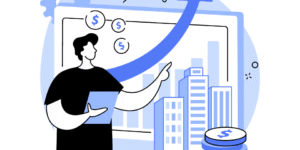In commercial real estate investment, there is no metric more prevalent than the cap rate. For transactional real estate investors, it’s a powerful tool used to vet prospective acquisitions, track income gains, and calculate returns. In essence, a commercial cap rate is a measure of return and risk on an investment asset.
While we’ve said before that real estate investors “live and die by the cap rate,” it’s not a straightforward measure of risk and return. Although the cap rate remains an important metric, in practice, developers use them quite differently than their investor colleagues.
Here’s what you need to know about using cap rates and development spread to assess your next project’s viability.
Cap Rate Defined
First, let’s break down the cap rate definition. A capitalization rate is a representation of risk and return on an investment asset. Expressed as a percentage, it’s calculated by evaluating the relationship between net operating income (NOI) and asset value. The formula is simple: Divide the asset’s NOI (annual gross operating income minus expenses) by the asset’s sales price. A property with $50,000 in annual NOI and a sales price of $1 million will have a 5% cap rate.
Cap Rate Calculation
Cap Rate = NOI/Asset Sale Price
You can easily find the formula and calculate the rate; there are an endless number of blog posts explaining this equation at length—but what does a 5% cap rate mean? Rather than thinking of a cap rate as “good” or “bad,” it’s better to think of it as a balance of risk and reward.
For example, a property with a healthy, stable income will likely trade at a higher price, and therefore carry a lower cap rate. While the low CRE cap rate would indicate a lower return, it’s also a lower risk; the income is secure and reliable. Alternatively, an investor can buy a property with a high vacancy, below market rents or deferred maintenance that is trading at a price below replacement cost, therefore carrying a higher CRE cap rate. In this latter example, although the property has more opportunity for yield, it’s also a higher risk investment. The cap rate will reflect both.
Cap rates vary by asset class, as well. Traditionally, multifamily assets – known for their stable income and steady demand – have the lowest cap rate in commercial real estate. Industrial assets, which are cheap to build and operate but generate strong rents and demand, also have low cap rates. Office and retail properties usually sit about 100 basis points above multifamily cap rates, although it can vary greatly based on the geographic market and economic fundamentals.
Cap rates will be impacted by a change in property value or a change in NOI. Ideally, investment strategy will drive these changes, improving NOI or making improvements that increase property value. Likewise, a long hold period would realize an increase in property value, increasing the return potential for the owner. However, outside factors can also impact a cap rate. Cap rates tend to rise in step with interest rates, which lower buying capacity and put downward pressure on property values. Weak economic fundamentals can reduce demand or create a negative rent growth environment, impacting cap rates and therefore profitability.
All of these factors can be rolled into a cap rate, which is what makes the metric such an ideal expression of yield.
For Developers, It’s All About the Spread
Cap rates are vital for real estate investors. It’s an easy way to make a side-by-side comparison of an asset, all else (like capital improvement plans and debt service costs) aside. However, real estate developers use a development spread to determine the risk and return potential of an investment. A development spread is the difference between the entrance and exit cap rate on a project. Developers typically aim for a spread of 150 to 200 basis points between the starting cap rate and exit cap rate, also known as the going in and going out cap rate.
Because developers start with raw land, not a cash-flowing property, the going in cap rate, also known as yield on cost, is calculated by the cost of the development and the estimated net operating income upon completion. If a developer is building a property with a $5 million budget and an estimated NOI of $500,000, the going in cap rate is 10%. If a developer expects to sell the property for $6 million and maintain an NOI of $500,000, the exit cap rate is 8.3%, a development spread of 1.7% or 170 basis points.
Unlike standard CRE cap rates, which have a built in NOI, a development spread is based on forecasted NOI, project budget and property value. Developments come with a substantially higher going in cap rate than an existing property because there is an inherent risk in achieving financial targets. When a market is producing higher spreads, above 250 basis points, a development is a more opportunistic and lucrative venture, and when spreads narrow, development carries a higher risk and reduced return potential. Like a cap rate, developers can use a development spread to understand the viability of a prospective project.
Achieving Your Pro Forma
A pro forma is a project’s estimated revenue and costs. At the start of a development, nearly all financial modeling is based on estimates—the estimated development budget, the estimated NOI and the estimated property value upon completion. Many of these figures won’t be final for one to four years following the start of a project. To make a project viable, it is tremendously important that developers hit their targeted pro forma. Using a development management technology like Northspyre can help achieve a project’s pro forma by better managing financials, automating administrative tasks and predicting challenges and issues before they impact the budget or timeline.
Northspyre’s technology, for example, has helped developers deliver final projects 6% under budget and reduce overages by 66%. The software also reduces administrative tasks by 80%, eliminating human errors that can lead to costly and time-consuming mistakes. Predictive analytics and automation is helping developers better utilize their time, make proactive decisions and ultimately meet pro forma figures. In the end, that preserves the targeted development spread and ensures a profitable outcome.
A cap rate is a simple equation that has numerous applications based on an individual investor’s needs. For developers, the spread between the going in cap rate and exit cap rate is the best way to estimate profitability and test the risk of a development.
Want to discover the three key steps to creating a successful scale-up strategy? Download Scaling Teams: A Real Estate Developer’s Blueprint to Success to discover how you can successfully scale your firm to boost profits, spread risk, and expand into larger markets.



